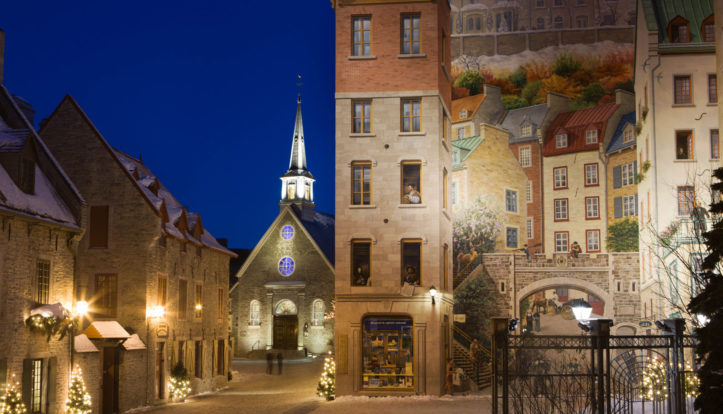Now that the sun shines a little less hot and that cooler evenings are more frequent, it is very pleasant to walk around town and explore its charms from a closer perspective. Did you know that Québec City is home to several fresco wall paintings that depict its rich history and that of its inhabitants in an original and appealing manner? We would like to present a few of them, and put in a some attractions nearby to complement the tour.
A Fresco Story
The practice of painting frescoes largely spread in twentieth century Europe and North America. Given the extremes of Quebec climate, most notably the shifting of seasons, numerous precautions are taken to preserve the beauty of frescoes, and ensure their durability. Frescoes found in Québec City are mainly of historical nature. They are recent works, performed mostly in the framework of a corporate order related to the 400th anniversary of the founding of Québec City. They are the result of the hard work of Murale Création, a Canadian group made up of artists from Lyon and Quebec. Albeit recent, Québec City frescoes are already part of the city’s cultural heritage, and capture the interest of strollers, local people and tourists alike.
La Fresque des Québécois
Painted in 1999, La Fresque des Québécois is the first of the mural paintings. It covers 420 square feet, from Maison Soumande’s wall to the immediate vicinity of Place Royale.
The decor integrates architectural features such as the ancient houses on Place Royale, the stairs connecting uptown and downtown, and the fortification wall circling Old Quebec. The artists also depicted the alternating seasons with the colour-changing vegetation.
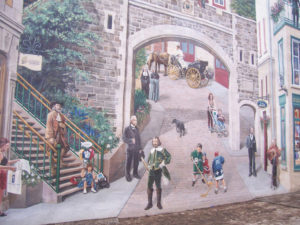
Trompe-l’oeil characters allude to the city’s history: we can discern Québec City founder Samuel de Champlain, Ursuline nun Marie de l’Incarnation, New France intendant Jean Talon, and more contemporary figures such as singer-songwriter Félix Leclerc… And even fictional ones such as Bonhomme Carnaval!
This fresco also reflects the different cultural communities of the capital: Native Americans, French and British settlers, Irish immigrants and, of course, today’s Quebecois from a multicultural background.
To do in the area While you are in this very nice district, make sure to visit one of many art galleries. Craving a snack or a meal? Grab a bite in the wonderful vaulted cellars of the Pub de l’Oncle Antoine (29, Saint-Pierre Street) or enjoy a square meal at one of the numerous restaurants on Sous-le-Fort and Saint-Pierre Streets.
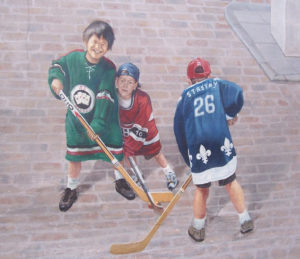
La Fresque du Petit-Champlain
Located at 102, Petit-Champlain Street, near Place Royale, this fresco adds to the charm of the street, which is one of the oldest in America.
This wall painting is another trompe-l’oeil that depicts the daily life of this working-class, port district located between Cape Diamond and the St. Lawrence River. Life-sized inhabitants and historical figures can be seen performing fishing and maritime trade activities. For instance, it portrays Lord Nelson, a British officer who fell in love with a Quebecoise, and Captain Bernier, a navigator from Quebec who explored the North Pole. Tragic events that happened in the neighbourhood are also rendered: the bombardment of the city in 1759 during the Seven Years’ War, and the deadly Quebec Rockslide of 1889.
This work has been created in 2001, and restored in 2016.
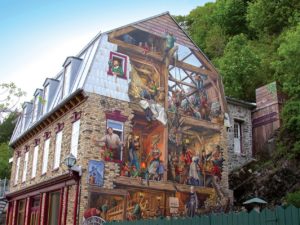
To do in the area This area hosts numerous attractions including artisans’ workshops (clothes, hand-blown glass, Quebec, Aboriginal and Inuit craft shops), local products boutiques, Quebec cuisine restaurants, brewpubs, etc.
La Fresque BMO de la capitale nationale du Québec
Taking up the west wall of the Marie-Guyart building, located at 1037, De La Chevrotière Street, the 450 square meters of La Fresque BMO de la capitale nationale du Québec portrays Quebec’s political history and pays tribute to Québec City as a political capital.
We can see the facade of the Parliament building, headquarters of Quebec’s National Assembly, and various figures from Quebec’s political history: Louis-Joseph Papineau, Louis-Alexandre Taschereau, Eugène-Étienne Taché, Marie-Claire Kirkland-Casgrain, first woman elected to Quebec’s National Assembly, René-Lévesque and Robert Bourassa. Several momentous events and Quebec political groups are also depicted in this fresco.
It was inaugurated in 2008, just in time for the 400th anniversary of the founding of Québec City.
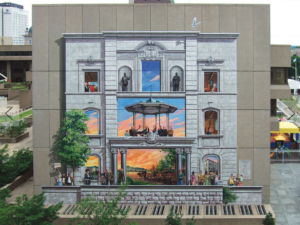
To do in the area While you are there, make sure to climb to the top floor of the Marie-Guyart Building; the Observatoire de la Capitale offers a spectacular view of the city and its surroundings.
The Dismantled Fresco
Even if we cannot see it anymore, we should mention La Fresque de l’Hôtel-Dieu de Québec. Created in 2003, this 420 square feet work used to cover the outer walls of the Hôtel-Dieu de Québec teaching facility, at the corner of Charlevoix Street and Côte du Palais.
This fresco revealed momentous events of the oldest hospital in North America, nothing less! Divided into five historical paintings retracing the practice of medicine in Québec City from 1637 to this day, it has been dismantled right before the facility fell victim to the wrecker’s ball in 2011. The panels have since been stored. Who knows, maybe the fresco will reappear on the future buildings of the hospital complex…
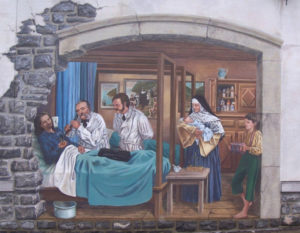
To do in the area This sector, adjacent to prime Saint-Jean Street, offers numerous attractions. It is possible to stroll for hours, stop by Librairie Pantoute, visit the Morrin Centre and explore its interactive exhibit on capital punishment, or enjoy a menu inspired by the boreal forest at Chez Boulay. There are plenty of opportunities.
* * * * *
At any moment, ask us questions or let us know what you expect of a great outing. Our expert team will give you detailed advice and maybe even help you develop a route for your trip to the city and its surroundings… Gourmet stops included!
